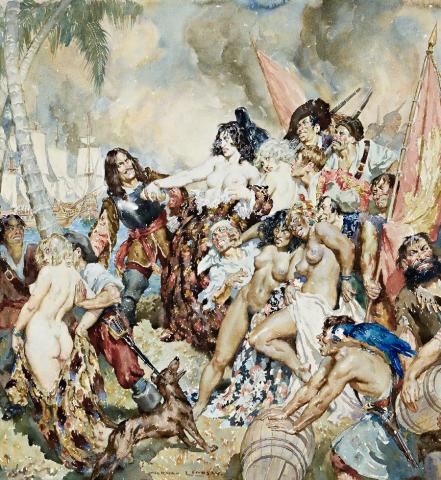LADIES FOR RANSOM, c.1938
NORMAN LINDSAY
watercolour on paper
66.0 x 61.0 cm
signed lower centre: NORMAN LINDSAY
Private collection, Melbourne
Thence by descent
Collection of Dr McKellar-Hall, Perth
Thence by descent
Private collection, Sydney
Deutscher and Hackett, Melbourne, 29 April 2009, lot 95
Company collection, Melbourne
Collector's Pride, Art Gallery of Western Australia, Perth, 3–26 June 1977, cat. 60 (label atached verso)
Ladies for Ransom, 1938, oil on canvas, 152.4 x 121.9 cm, private collection, in Bloomfeld, L., Norman Lindsay Oil Paintings 1889–1969, Odana Editons, Bungendore, 2006, pp. 120–121 (illus.)
As Norman Lindsay watercolours go, Ladies for Ransom is a tour-de-force, full of buxom ladies and lustful pirates of all kinds and degrees. Lindsay was fascinated by the romance of the high seas and the cut-throat buccaneers who plied its waters. Equally, his art dwelt on abduction and seduction, where bare-bosomed beauties are at the mercy of these seafaring vagabonds. It was a favourite subject, addressed in related watercolours such as the 1939 Filibusters' Heaven, Captured 1938, and Porto Bello 1943, variations on the pirate king and the mantilla-wearing wench often being the centre piece.1 In Ladies for Ransom, the chief pirate is dressed in the style of a Royalist cavalier, those romantic figures from the seventeen-century who fought so gallantly against the Roundheads of Cromwell and his pleasure-denying Puritans. Longhaired, mustachioed, breastplate of metal and a scarlet sash around his waist, he takes the hand of the black-haired beauty who, with her other ladies, seems a little taken aback by the events. They are in all states of déshabillé, as the metaphorical dark clouds of the passionate struggle give way to blue skies and sunshine. Lindsay knew well that the partly clad female was equally if not more enticing that the fully presented nude. And he was broadminded in his choice - Nordic blondes, dark haired senoritas, Negro beauties from Africa - all bounteous front and backsides. The buccaneers come off second best, ranging from the debonair main figure, through various stages of grimness to the hairy Neanderthal on the lower right. A keg of rum is rolled in and the festivities are about to begin, for not all the ladies seem averse to the situation in which they find themselves. Flags fly triumphantly as Lindsay titillates with occasional vertical accents, the flicker of light across the picture surface giving the whole painting a further liveliness and verve. To the left, palm trees arch gracefully upwards, the prominent blue-tailed parrot adding another exotic touch. Lindsay, being a gifted maker of models, loved ships, especially those tall masted galleons. The two full-sailed ships to the left are, therefore, obligatory and add more touches of romantic glamour to this pageant of expected pleasure. In his lifelong battle against wowserism, Lindsay was a master of the erotic and exotic, delighting in the beauty of the female form. As in this painting, he used his considerable illustrative power to attack prudery wherever he found it. His pirate paintings were ever popular, Lindsay writing 'I have never painted a piratical subject that has not been snatched up by buyers when exhibited.'2
1. Blunden, G., Norman Lindsay Watercolours, Ure Smith, Sydney, 1973, see colour plates 1, 5 and 9 2. Norman Lindsay, undated letter to John Hetherington, quoted in Bloomfield, op. cit., Norman Lindsay Watercolours 1897 -1969, Odana editions, Bungendore, p. 126
DAVID THOMAS
